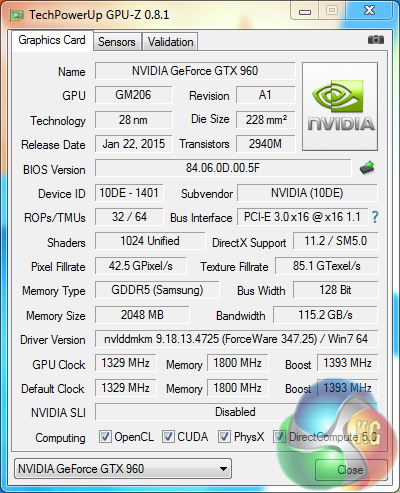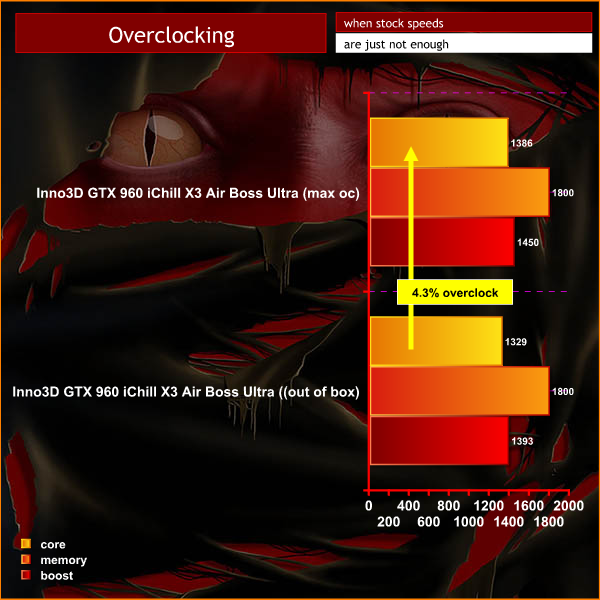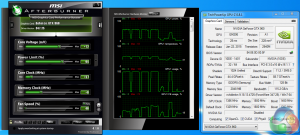The new GTX960 incorporates Nvidia's GM206 GPU. The GM206 features all the primary architectural innovations we discussed when the GTX980 launched last year. The Maxwell GPU uses a new SM design that has been designed to enhance efficiency.
The Maxwell SMM is partitioned into four 32 CUDA core processing blocks (128 CUDA cores per SM), and each of these has its own dedicated resources for instruction buffering and scheduling. Nvidia's design is based around keeping the GPU CUDA cores fully utilised more often to improve workload efficiency, and to reduce wasted power.

Each of the GM206 SMM units have their own 96kb shared memory, and the L1/texturing caching functions are combined into a 24kb pool of memory per pair of processing blocks (48kb per SMM). Previous Kepler GPU's had a smaller 64kb shared memory function which was also shared as a L1 cache.
Nvidia have calculated that each GM206 CUDA core can deliver 1.4 more performance per core compared to the GM106 Kepler core, with a 2x performance ratio per watt.
While many will negatively focus on the 128 bit memory interface of the new GTX960, Nvidia have added a new memory compression engine.
This third generation colour compression engine offers new modes for colour related compression which will have a positive impact on how the GPU effectively uses available memory bandwidth. Nvidia say that the GM206 uses approximately 25% fewer bytes per frame compared to previous generation Kepler products. Nvidia claim that the 128 bit, 7Gbps memory interface in GM206 is able to provide more bandwidth than its direct predecessor, the GK106. (148.8GB/sec effective in GTX 960 vs 144.2GB/sec in GTX 660).
The GTX960 will support resolutions up to 5k with up to four simultaneous displays, and support for up to four 4k MST displays. The card also fully supports HDMI 2.0.
While the GTX750ti seems an ideal partner for a media center build, Nvidia also claim in their literature that the GTX960 is a good choice for the same task. The GM206 has support for H.265 (HEVC) encoding and decoding. The GTX980 NVENC video engine offers native support for H.265 encode only, no decode. GM206 also fully supports HDCP 2.2 content protection over HDMI.

The Nvidia reference specifications are 1,125mhz (core) and 1,753mhz memory (7Gbps effective).
Inno3D have cranked the GM206 core on this card very highly, to a core clock speed of 1,329mhz – the highest we have tested yet. The Boost speed is running close to 1,400mhz out of the box, at 1,393mhz. The memory receives a boost to 1,800mhz (7.2Gbps effective) from 1,753mhz (7Gbps effective).
As the majority of our readers are likely to buy a GTX960 to run in a highly overclocked state, we felt we would get the overclocking section out of the way, first. Throughout this review we will run all tests with the Inno3D GeForce GTX 960 iChill X3 Air Boss Ultra at ‘out of box' speeds, as well as the maximum stable overclocks we were able to achieve.


We managed to push the core to 1,386mhz, and the boost to 1,450mhz. This is close to a 4.3% increase over the overclocked speeds that the BIOS is coded to. This translates to a final enhanced clock speed of 23.2% over Nvidia reference speeds.
 KitGuru KitGuru.net – Tech News | Hardware News | Hardware Reviews | IOS | Mobile | Gaming | Graphics Cards
KitGuru KitGuru.net – Tech News | Hardware News | Hardware Reviews | IOS | Mobile | Gaming | Graphics Cards



3.5GB* -_-
IT’s THE DAMN 970 AGAIN 😛
☑☑MAKE $13500 in 30days@a13:
Going Here you
Can Find Out,,
►►►►►► https://Up2DateFinanceWorks11.com/get/position…
fantastic review! thanks a ton.
did you even read the review ? It clearly states It’s a 2GB card.. -_-
You can go to youtube and see it play games.